GDP per capita is a standard metric used for evaluating the prosperity of nations. Economists use it, alongside GDP, to analyze the wealth of a country based on its economic growth. Small, rich, and more developed industrial countries usually have the highest GDP per capita. But is this metric the most appropriate way of determining how poor a country is? Nominal GDP/capita is just the raw GDP divided by the population; it does not take inflation into account and uses market exchange rates to make conversions. A more effective way of representing the living standard (and thus level of poverty) of a country is to use PPP (Purchasing Power Parity) when calculating GDP/capita. PPP is an exchange rate based on the price of goods and services, not just the market value of the nation’s currency.
 An infographic showing the 15 poorest countries in the world, as well as there locations and GDP/Capita
An infographic showing the 15 poorest countries in the world, as well as there locations and GDP/Capita
The world’s poorest countries exhibit similar challenges at the root of their impoverished states and trends of no foreseeable respite. Many stay locked in poverty with corrupt governments, a lack of essential services, and further hindrance by climate change and tumultuous events worldwide. Soberingly, 19 of the 20 poorest countries in the world are African. To advance economically, most require funds and political stability to help modernize and expand relevant industries and trade for social progress and financial stability. This list uses data from the International Monetary Fund (IMF) to discuss the 15 countries with the lowest GDP per capita.
1. Burundi – $905.01
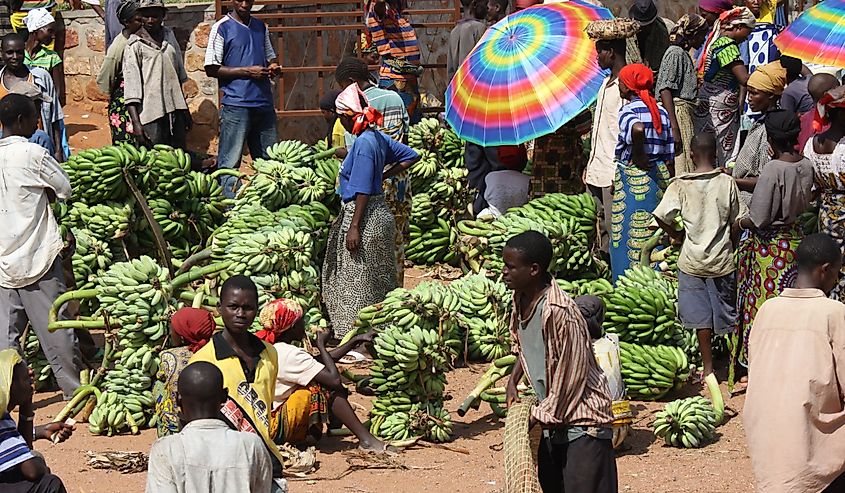 Burundian people at the market, Burundi. Image credit Rostasedlacek via Shutterstock
Burundian people at the market, Burundi. Image credit Rostasedlacek via Shutterstock
The small, landlocked country of Burundi, gained independence from Belgium in 1962 but is still ridden with violence. In 1965 there was the infamous Hutu-Tutsi ethnic conflict. Although the civil war ended over 15 years ago, the world’s poorest country is wrought with endemic corruption and security concerns. Cities lack infrastructure, with very limited access to electricity, sanitation, and clean water. Most residents complete only three years of education, and there are 740 deaths per 100,000 live births.
The poverty-stricken population of some 12 million relies on scarce agriculture to feed and provide for their family. Climate change and crop failure-induced food insecurity is almost twice the average of other sub-Saharan nations. Although the US and EU lifted imposed financial sanctions following the political crisis in 2015 with some aid restored, the pandemic and war in Ukraine exacerbate the country’s challenges.
2. South Sudan – $993.23
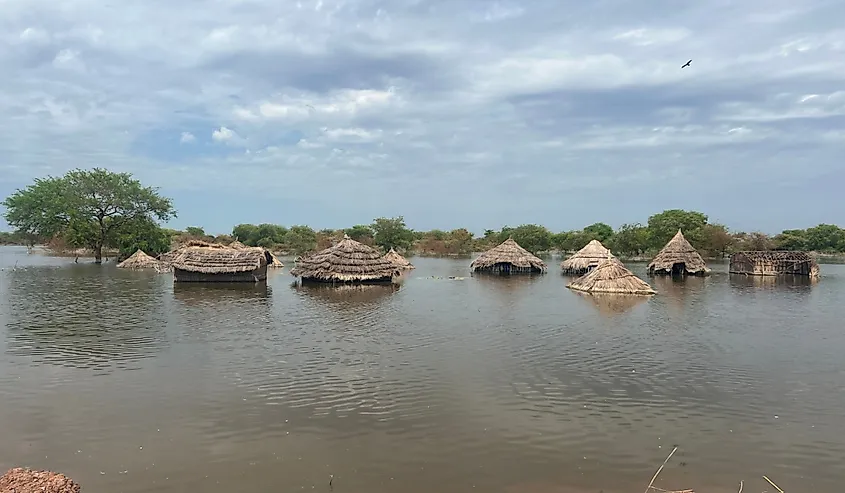 Flood-affected deserted houses in South Sudan. Image credit rameesha bilal shah via Shutterstock
Flood-affected deserted houses in South Sudan. Image credit rameesha bilal shah via Shutterstock
South Sudan was born out of an agreement that ended Africa’s longest-running civil war and formed on July 9, 2011, from Sudan’s ten southernmost territories. It is the world’s newest nation and already second-poorest with 11.5 million inhabitants including 60 indigenous ethnic groups living amidst poverty and persistent violence. The 2018 conflict ended in a violent coup, a 400,000 death toll, and 4 million internally displaced or fleeing. South Sudan failed to draft a permanent constitution and pushed the first election back to late 2024.
The oil-rich but “resource-cursed” country is a scene of inequality, social and political divisions, corruption, and lack of economic diversity with high dependence on one commodity. The majority relies on traditional agriculture and heavily on international humanitarian aid. Droughts and floods leave nothing to cultivate, consume, and trade. There is no foreseen progress, and only worsening from a depreciated currency and supply disruption from Ukraine.
3. Central African Republic – $1,140
 Children playing football on streets in Bangui, Central African Republic. Image credit sandis sveicers via Shutterstock
Children playing football on streets in Bangui, Central African Republic. Image credit sandis sveicers via Shutterstock
Central African Republic is the third poorest by GDP/capita but the world’s hungriest with the 2018 Global Hunger Index (GHI) indicating “extremely alarming” levels. The majority of the 5.4 million residents live at or below the poverty line, with a life expectancy of only 52.9 years.
Residents manage to complete 4.3 years of schooling amidst lives disrupted by violence and sectarian fighting since 2013. The conflict developed into a full-blown humanitarian crisis with water shortage, lack of sanitation, and one of the world’s highest child mortality rates. People struggle daily to survive, with an additional 13% of Central Africans in need since March 2018, and a million fleeing from the devastated country.
4. Somalia – $1,370
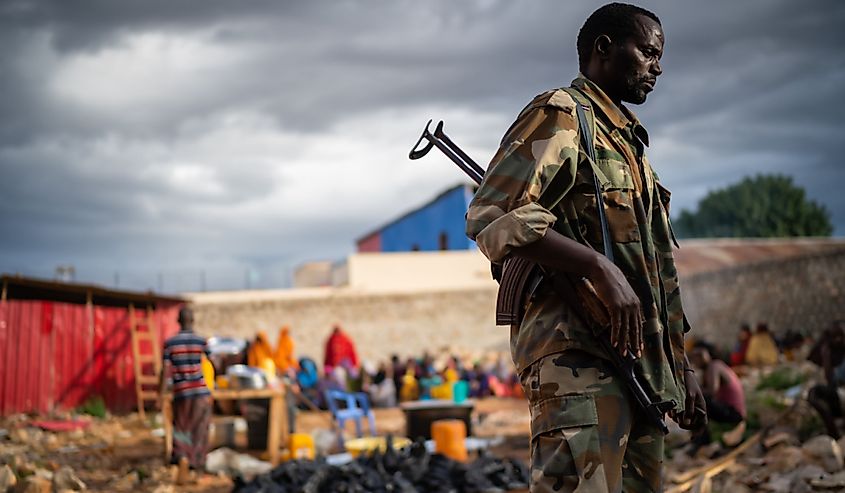 Soldier on duty to protect people during dinner, Baidoa, Somalia. Image credit sntes via Shutterstock
Soldier on duty to protect people during dinner, Baidoa, Somalia. Image credit sntes via Shutterstock
The country in the “Horn of Africa” is full of poverty and wrecked with violence from decades-worth of conflict while the government focused on security. By the time troops pushed back the Islamist Al-Shabaab, the nation was knees-deep in poverty. A smooth election in May landed the quasi-independent Republic of Somalia, and DP World’s new container terminal at the Berbera port should support trade.
However, years of political instability, rising inflation, and a poor business environment deem the country unreliable to investors and consumers. Somalia is also highly vulnerable to droughts, with food scarcity, a low vaccination rate, and a forecasted weak economy, according to the Economist Intelligence Unit.
5. The Democratic Republic of the Congo – $1,420
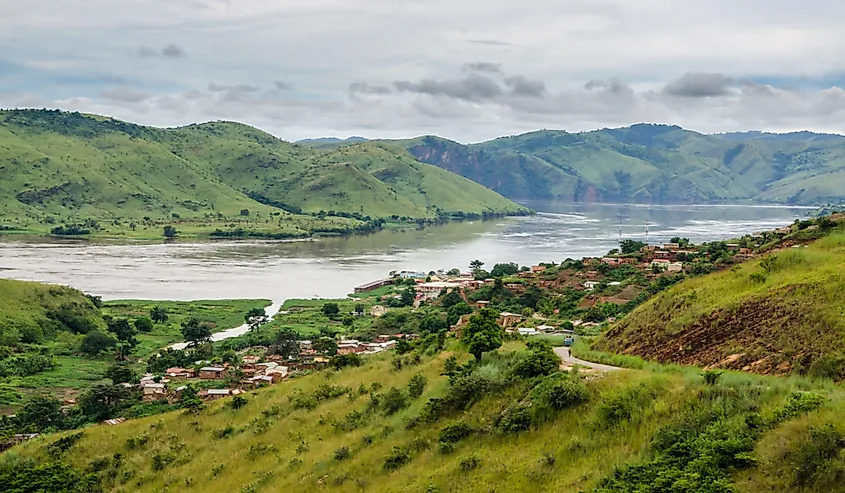 A small village in green hills at Congo River, Democratic Republic of Congo. Image credit Fabian Plock via Shutterstock
A small village in green hills at Congo River, Democratic Republic of Congo. Image credit Fabian Plock via Shutterstock
The Democratic Republic of the Congo is home to over 80 million hectares of arable land, thousands of minerals, and valuable metals. It is also the world’s largest producer of cobalt and Africa’s leading source of copper, with the potential to drive the economy of the whole continent. The country emerged independent from Belgium in 1960 only to go through decades of political instability and endemic corruption.
The Great African War saw 6 million lives lost in fighting, disease, and malnutrition, followed by persistent Ebola outbreaks, and a recent resurgence of violence. DR Congo’s median age is 17, with 64% of the 90 million population surviving on less than two dollars per day.
6. Mozambique – $1,540
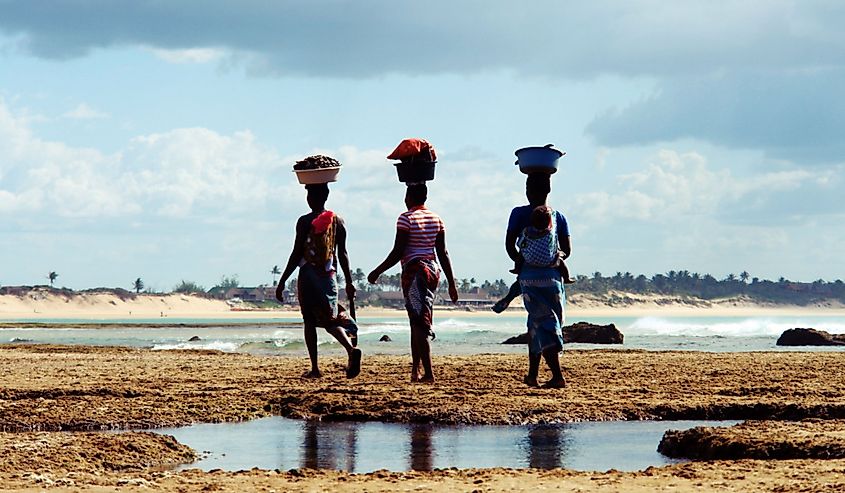 Mozambique women carrying a basket on the head and baby behind the back walking home after looking for mussels at Tofo beach, Mozambique. Image credit Aostojska via Shutterstock
Mozambique women carrying a basket on the head and baby behind the back walking home after looking for mussels at Tofo beach, Mozambique. Image credit Aostojska via Shutterstock
The over 30 million citizens of the former Portuguese colony receive 3.5 years of mean education. Despite plenty of arable lands, mineral resources, energy, and water access, large sections of the population live in poverty. After the 15-year-long civil war ended in 1992, corruption and political instability stayed, while intensified fighting from April 2011 deemed the country unreliable to investors.
Islamic insurgent groups have hit the gas-rich northern parts since 2017, killing some 4,000 people, and displacing 800,000. Although four landlocked countries around depend on Mozambique to conduit global trade, it is not enough to remedy the effects of severe weather, floods, and crop destruction that continue to devastate the scarce food supply.
7. Niger – $1,550
 African boys on an open truck full of vegetable bags pumpkins near Niamey city, Niger. Image credit Katja Tsvetkova via Shutterstock
African boys on an open truck full of vegetable bags pumpkins near Niamey city, Niger. Image credit Katja Tsvetkova via Shutterstock
Niger is a landlocked country with an 80% desert landscape and rapid population growth contested by small-scale agriculture. Climate change and desertification led to three major agricultural crises within ten years and food insecurity like never before. Niger is an unstable state since independence, with military coups, army clashes, and the Islamic State (ISIS) that displaced thousands. There is also volatility around gold and uranium extraction, along with low commodity prices.
Niger is a resistant nation with a life expectancy of 60.4 years and an average of two years of schooling. Its daunted development is further exacerbated by terrorist incursions, migration, and overpopulation. In the last decade, nearly half lived in extreme poverty, which continues to manifest in high mortality rates, endemic malaria, and lack of services, sanitation, and safe water access.
8. Malawi – $1,640
 Rural village in Malawi. Image credit Magdanatka via Shutterstock
Rural village in Malawi. Image credit Magdanatka via Shutterstock
Malawi is economically-constrained from relying singularly on one agricultural crop subsistence of tobacco. The limited financial abilities and poor business environment cannot support the populace. There is immense public debt in fiscal and current account imbalances with heavy reliance on international financing. People lack services from crowded-out private investment and businesses interrupted by electricity blackouts.
Malawi is vulnerable to extreme weather occurrences and inconsistent rain-fed agriculture. Food scarcity worsens due to the war in Ukraine that shocked commodity prices, rocketed interest rates, and inflation. The country needs to expand its export base in tandem with greater mining investment, but despite a semi-functioning multi-party democracy since the early 1990s, the fragmented Parliament has been unable to corrugate any viable actions.
9. Liberia – $1,760
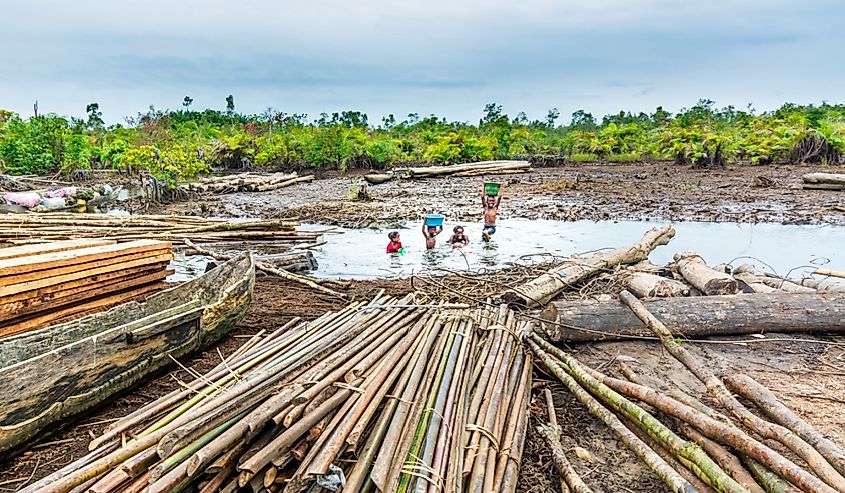 Children bathing and playing in the river, Wamba town, Liberia. Image credit Dan_Manila via Shutterstock
Children bathing and playing in the river, Wamba town, Liberia. Image credit Dan_Manila via Shutterstock
Africa’s oldest republic exhibits a long history of suffering with a period of civil wars from 1989 to 2003. Liberia was later hit by West African Ebola with 10,675 infected and 4,809 dead between 2014 and 2016. Finally achieving peace, the country still struggles with poverty with every-third child stunted from malnutrition.
In 2016, half of the population lived below the poverty line and most children completed less than five years of school. More than 42% of Liberians lack access to clean water, as the basis repatriation effort needed to offset poverty. There is also persistent malaria and gender-based violence, and no initiative by the state to combat any of the challenges.
10. Chad – $1,790
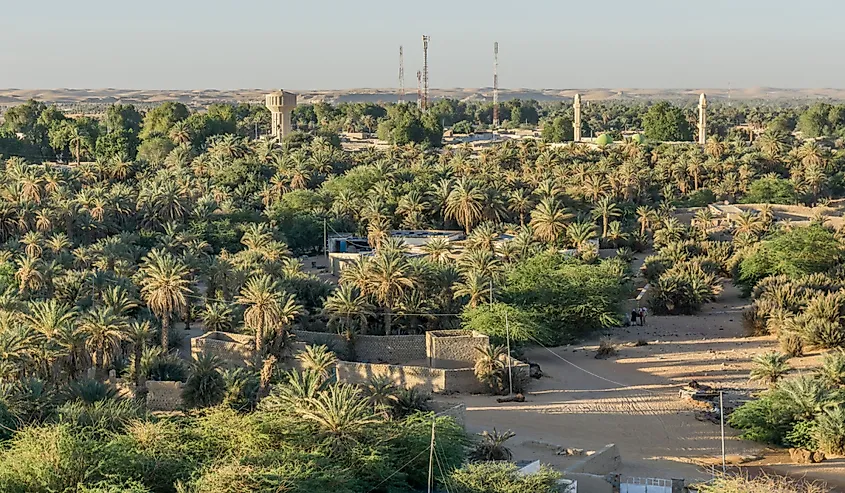 Faya largeau Oasis, Ennedi massif, sahara desert, Chad. Image credit Torsten Pursche via Shutterstock
Faya largeau Oasis, Ennedi massif, sahara desert, Chad. Image credit Torsten Pursche via Shutterstock
Upon oil-discovery early this century, the former agrarian country became the tenth-largest oil holder on the continent. There was a law requiring to consult before spending public money, and reserve 80% of royalties and 85% of dividends to fight poverty. Instead, the autocratic government since 1990, Déby, spent most funds on militia in lieu of financing communities, developing infrastructure, and bettering health and education provision.
Despite his attempts to crack down on the opposition and arising discontent, he died in armed conflict, at the hands of his son. The military dissolved the constitution, government, and parliament, cowing a “free and democratic” election after 18 months of a “transition period”. With all the potential, Chad stands among the world’s poorest nations, and near the bottom of the United Nations Human Development Index.
11. Madagascar – $1900
 Two Malagasy young men pushing a wagon on a marketplace street in Madagascar. Image credit Artush via Shutterstock
Two Malagasy young men pushing a wagon on a marketplace street in Madagascar. Image credit Artush via Shutterstock
The fourth largest island in the world, 250 miles off East Africa’s coast has a thriving tourism industry. While tourists enjoy the beaches, natural beauty, and wildlife, the majority of locals try to make ends meet with heavy economic dependence on agriculture. Madagascar is vulnerable to worsening weather-related disasters and crop destruction. It has one of the world’s highest childhood malnourishment and growth stunt rates, with famine worsened by collapsed grain delivery from Russia and Ukraine, along with skyrocketing food prices.
Since its independence in 1960, Madagascar is a scene of political instability with violence, empty promises, contested elections, and corruption. The inept government did nothing when the pandemic hit. With a population dependent on the tourism industry, many found themselves out of work. The sharp recession and crumbling manufacturing sector depleted all fiscal resources, spent instead on priority investments, and social programs.
12. Sierra Leone – $2,070
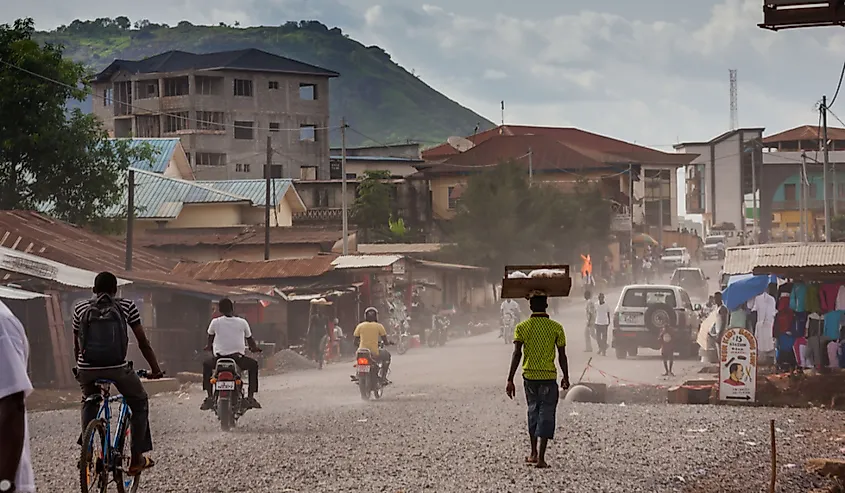 People along the Makeni highway, Sierra Leone. Image credit robertonencini via Shutterstock
People along the Makeni highway, Sierra Leone. Image credit robertonencini via Shutterstock
Sierra Leone’s economy was long-exhausted following 11 years of civil war until 2002. Nearly 53% live under the poverty line. In addition, the Ebola epidemic in 2014 further hit the economy by decreasing employment and trade. The conflict in Ukraine skyrocketed import prices, hit purchasing power, and spurred violent protests against the government.
The country’s narrow export base of metals, wood, diamonds, and cocoa is poorly managed, with limited fiscal space. The residents complete a mean of 3.5 years of education with a life expectancy of 52.5 years. Sierra Leone faces environmental challenges, potential emergencies such as the 2017 mudslide, and the risk of losing food and livelihoods. Projections for progress in the next election scheduled for 2023 are bleak.
13. Eritrea – $2,170
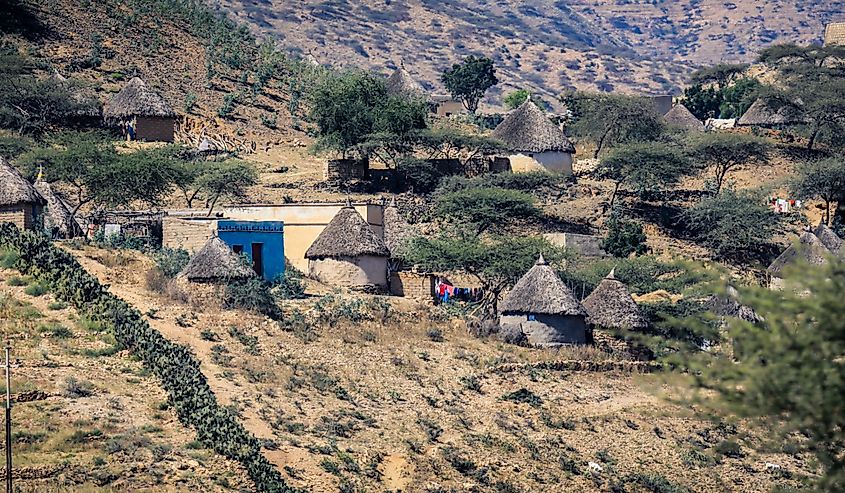 Small Local Village with Typical Keren Houses, Eritrea. Image credit Dave Primov via Shutterstock
Small Local Village with Typical Keren Houses, Eritrea. Image credit Dave Primov via Shutterstock
Eritrea’s economy is crumbling despite recent export income from zinc, gold, and copper. With 80% of residents working in agriculture, they only feed at best 60% to 70% of the population. Less than half of the rural population had access to clean water in 2015, while customs around sanitation keep Eritrea disease-ridden. Droughts lead to months-long food shortages and countless children with acute malnutrition.
The country with the “no war, no peace” motto is a scene of violence ever since its separation from Ethiopia in 1993. Although the Eritrean War of Independence ended in 1991, the government focused all resources on military forces and guarding the territory. Eritrea has gaping federal deficit holes, the highest number of migrants in Africa, and ranked 0.351 on Human Development Index, below the 0.475 average of other sub-Saharan nations.
14. Yemen – $2,240
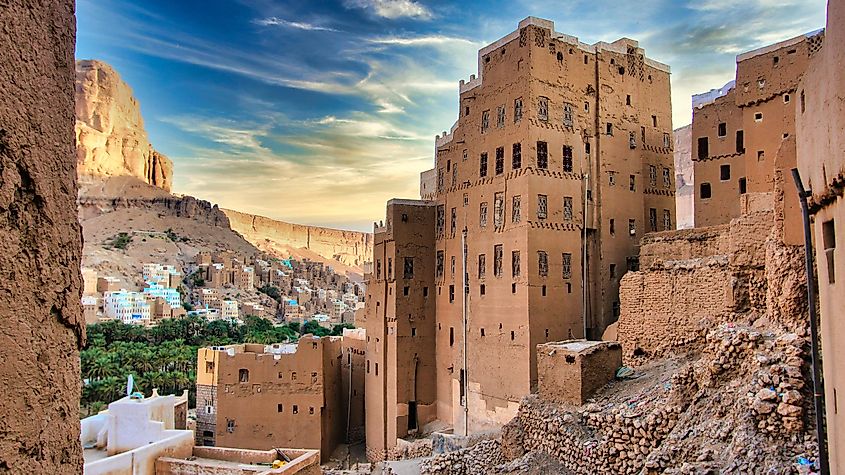 Historic mud-built buildings in Hadramawt, Yemen
Historic mud-built buildings in Hadramawt, Yemen
Yemen is one of the poorest Arab countries. It is highly dependent on declining returns from its small oil and gas reserves. A complex civil war, which started in 2014, has created a huge humanitarian crisis and has exacerbated economic challenges, unemployment, and food, water, and medical resource shortages. Now, there are two opposing governments: Hadi’s, based in Aden, and the Houthis in Sanaa. U.N.-brokered peace talks remain deadlocked.
The Yemeni civil war of 2014 has devastated the economy and permenantly damaged infrastructure. Even before the conflict, years of mismanagement and corruption and the exhaustion of oil and water resources had led to poverty, underdevelopment, and little access to basic services like electricity, health care, and water in most of the country. More than 70% of Yemenis depend on humanitarian assistance.
15. Kiribati – $2,260
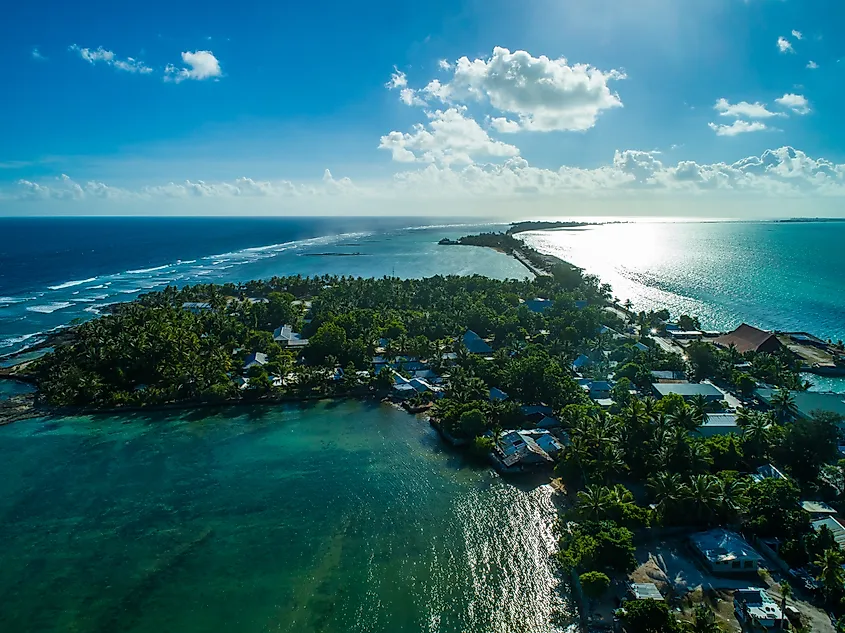 Aerial view of Kiribati
Aerial view of Kiribati
Kiribati is comprised of 33 scattered coral atolls; it has few natural resources. It is one of the poorest countries in Oceania and one of the least-developed Pacific Island countries. Kiribati became independent from the UK in 1979, and its government functions democratically. Economic activity once revolved around the mining of phosphates, but those deposits have been exhausted.
A $722 million fund created with mining revenues continues to support the government’s budget significantly. Kiribati relies on foreign assistance, emigrants’ sendings, fishing, coconut exports, and tourism. Devastating algae in the corals are a serious threat to the fishing industry.
Understanding Global Poverty In An Unequal World
Food scarcity, water shortage, and lack of sanitation are prerogatives to poor states that keep them poor. Most of these countries also have corrupt governments and persistent conflict, with resources focused elsewhere. Their persistent challenges produce similar projections and trends of little future respite to offset poverty.
There is a long way to go to enhance livelihood for these populations, starting with food security and nutrition repatriation, as well as access to clean water, quality health care, and education. However, global poverty is on the back-burner with other challenges and critical situations around the world.
The 50 Poorest Countries In The World 2023
| Rank | Country | GDP/Capita using PPP |
|---|---|---|
| 1 | Burundi | 905.01 |
| 2 | South Sudan | 993.23 |
| 3 | Central African Republic | 1140.00 |
| 4 | Somalia | 1370.00 |
| 5 | Dem. Rep. of Congo | 1420.00 |
| 6 | Mozambique | 1540.00 |
| 7 | Niger | 1550.00 |
| 8 | Malawi | 1640.00 |
| 9 | Liberia | 1760.00 |
| 10 | Chad | 1790.00 |
| 11 | Madagascar | 1900.00 |
| 12 | Sierra Leone | 2070.00 |
| 13 | Eritrea | 2170.00 |
| 14 | Yemen | 2240.00 |
| 15 | Kiribati | 2260.00 |
| 16 | Solomon Islands | 2430.00 |
| 17 | Zimbabwe | 2660.00 |
| 18 | Mali | 2760.00 |
| 19 | Burkina Faso | 2800.00 |
| 20 | Togo | 2810.00 |
| 21 | Gambia | 2810.00 |
| 22 | Vanuatu | 2950.00 |
| 23 | Guinea-Bissau | 3020.00 |
| 24 | Rwanda | 3060.00 |
| 25 | Lesotho | 3150.00 |
| 26 | Guinea | 3180.00 |
| 27 | Uganda | 3210.00 |
| 28 | Haiti | 3250.00 |
| 29 | Comoros | 3470.00 |
| 30 | Timor-Leste | 3550.00 |
| 31 | Tanzania | 3570.00 |
| 32 | Ethiopia | 3690.00 |
| 33 | Fed. States of Micronesia | 3910.00 |
| 34 | Zambia | 3980.00 |
| 35 | Benin | 4480.00 |
| 36 | Senegal | 4480.00 |
| 37 | Papua New Guinea | 4550.00 |
| 38 | Sudan | 4610.00 |
| 39 | Marshall Islands | 4660.00 |
| 40 | Cameroon | 4670.00 |
| 41 | São Tomé and Príncipe | 4900.00 |
| 42 | Congo | 4950.00 |
| 43 | Nepal | 5000.00 |
| 44 | Tajikistan | 5080.00 |
| 45 | Myanmar | 5140.00 |
| 46 | Kyrgyz Republic | 6050.00 |
| 47 | Cambodia | 6080.00 |
| 48 | Nigeria | 6120.00 |
| 49 | Tuvalu | 6240.00 |
| 50 | Samoa | 6300.00 |





